Ankylosing spondylitis (AS) is a type of arthritis characterized by long-term inflammation of the joints of the spine, typically where the spine joins the pelvis. With AS, eye and bowel problems, and back pain may occur … Ankylosing spondylitis is believed to involve a combination of genetic and environmental factors. More than 8% of people affected in the UK have a specific human leukocyte antigen known as the HLA-B27 antigen.
https://en.wikipedia.org/wiki/Ankylosing_spondylitis
The Beginning
I have written elsewhere about my first attack of ankylosing spondylitis in 1973, not that I realised what was happening to me or what was causing it. I was in Los Angeles at the time. It began with a searing pain in my lower spine and shooting pains in my upper legs.
When I returned to London, I visited a GP who sent me to Barnet General Hospital where X-rays showed nothing other than a healthy spine.
The attacks recurred, sometimes so severely I was unable walk.
I was referred to the National Orthopaedic Hospital in Stanmore. Yet, the result was the same
During the following 15 years, I consulted more GPs, one of whom claimed it was psychosomatic and that I was not to bother him again. I visited acupuncturists, chiropractors, and a private clinic in Wimpole Street where a doctor injected steroids into the base of my spine. Yet nothing or no-one could help.
I swallowed enough painkillers to drop a horse. A friend gave me lump of cannabis resin, instructing me to grate some into a cup of tea. I didn’t use drugs, at least not the illegal kind. Desperation forced me to try it. Sure enough the pain disappeared, but I was incapable of thinking and too drowsy to carry out the most trivial of chores. So that remedy didn’t last long. Instead I would wait until I could walk, usually with a limp, and then got on with my life.
At art school, these episodes recurred time and again. But hell, it was psychosomatic. Ignore it, I told myself, until one day I couldn’t.
Diagnosis
Shortly before Easter,1989, I began to experience an acute pain in my jaw. My GP thought it required a dental examination at University College Hospital Dental Clinic. Once again, a doctor ordered some X-rays, and sure enough the results were negative. She asked about my work. At the time I was working 16-hour shifts for the Inner London Probation Service (that’s another story). I also said that on my days off I was preparing for my first solo exhibition at the Camden Art Centre in London. This was a big deal and I wanted to exhibit new work.
She shook her head and said I was clearly under a lot of stress. So she prescribed Valium and sent me on my way.
The following day, Good Friday, my body told me something else. The pain in my jaw was now accompanied by severe pain and swelling in my knees, wrists and ankles.
I phoned my GP.
She said, “You’ve got ankylosing spondylitis. I happened to learn about it at medical school. I’ll get you to see a rheumatologist. In the meantime take Ibuprofen.”
On the day following Easter Monday, a friend drove me to Westminster Hospital, in Victoria, on the same street as my employer’s HQ, which later proved useful when I was forced to resign.
A rheumatologist, Rod Hughes, drained my joints of fluid., and prescribed, Naproxen, an anti-inflammatory drug. He also ordered a gene test that later proved I was carrying the HLA-B27 antigen. Finally, he warned me about the possible onset of uveitis.
I left the hospital that day in a state of euphoria. I had a diagnosis and surely that would be the end of it. Yet, of course, I was wrong.
I hadn’t paid enough attention to what he said, because AS was incurable. This was pre-internet days with no access to information other than a NHS leaflet.
I went to Suffolk for six weeks to recuperate. Trevor Jones, a great friend and former tutor at Camberwell Art School, offered me his home and the use of his studio, a large barn that he had recently converted.
I did my physio each morning. I took pills. I tried to make paintings.
My Camden exhibition went ahead. I did get another show in a West End gallery, and the occasional painting shown here and there. Yet the truth is I began to dislike the process of exhibiting my work. I always became unduly anxious whenever anyone showed interest in it, and the stress often triggered inflammatory episodes.
In 1990, I had an episode of uveitis, a searing pain in both eyes when looking at sunlight. Failure to receive prompt treatment was likely to lead to permanent damage of my eyes. I was in Brighton at the time, and rushed back to Charing Cross Hospital where an ophthalmologist applied drops to dilate each iris, and then another drug to stop the inflammation. This would be repeated for several few weeks, and because each iris would remain dilated, focusing on anything small was a problem.
I had been painting a series of small paintings. Fortunately the doctor had a solution.
“Work big,” he said.
Working Big
I rented a large studio, first in London Fields, and then in Stratford. I made huge paper collages. I also cut up old student paintings.
These works were of the order of 240 cm (8′), which meant I could focus on them at a distance.
So I learned how to cope with ankylosing spondylitis, at least for some of the time.



DVT
When I could no longer afford a studio, I worked at home. I made a series of drawings and mono-types. They were dark, reflecting my mood.
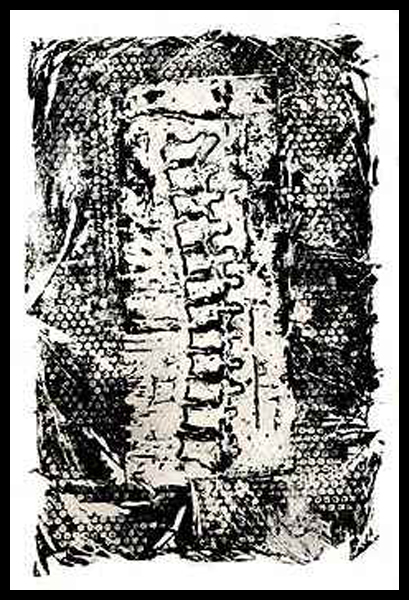
In 2005, I taught computer science for The Open University. tutoring more students than many of my colleagues. I was also employed by three other universities. Meanwhile, I studied a post-grad course with the OU.
Occasionally I managed to make art. Not much, but enough to keep me sane.
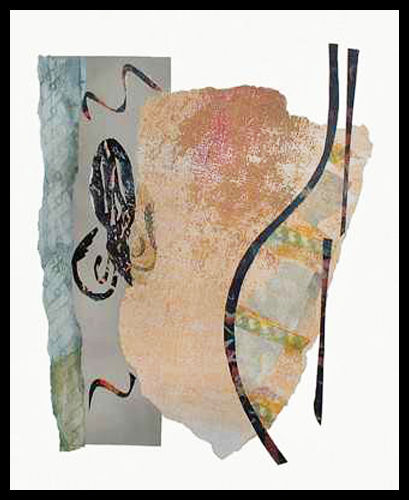
Then, I inadvertently ate a meal containing raw chicken.
I was violently sick in the night., and it took just a few days for the effects of the poison to fully kick in.
On a Saturday, I was teaching Java programming to a class in Reading. I began to feel ill. I wasn’t nauseous, but generally feeling under par. I got through that day and returned home. That’s when my knees and legs began to swell. I spent the next two days in bed, wracked with pain.
My family urged me to get treatment. On Tuesday, I saw my GP. She told me to get to A&E. A friend drove me to St Mary’s Hospital in Paddington. I collect London hospitals; I’m approaching a full set.
My GP phoned ahead., and I was instantly taken for emergency treatment. A Baker’s cyst in my right knee had burst, and the fluid had drained into my lower leg. An ultrasound confirmed a deep vein thrombosis (DVT) in the calf.
I was injected with heparin, and the following day I began self-injecting the same drug. Two weeks later I was put on Warfarin. But my knees were wrecked, and they never recovered.
That put paid to my career as a teacher. I had some minor knee surgery that year, and was told my knees would, in the future, require replacements.
“Hold off for as long as you can,” advised the surgeon. “It’s all rather medieval now. Things will improve.”
AS – The Wrecker
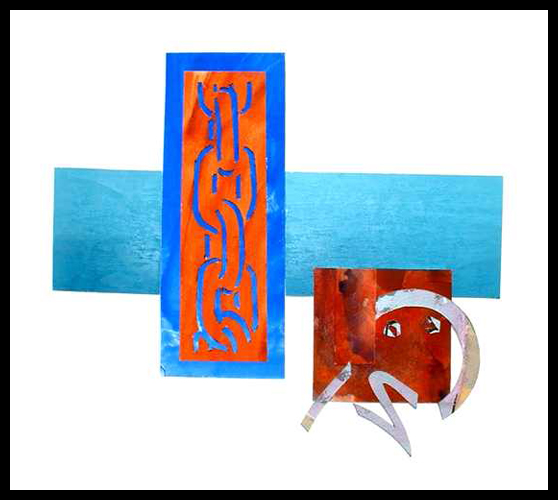
I was now a full-time artist. My knees deteriorated, but fortunately I was able to paint. I walked a lot, which I guess accelerated the wear and tear. A few years later, I travelled abroad. I had a good life. However I began to notice another insidious symptom creeping up on me.
I was experiencing episodes of extreme fatigue, the kind that only sleep and complete rest could remedy. I regularly developed flu-like symptoms and I couldn’t think straight. These episodes would last for a week., sometimes longer When it happened, I disappeared from life, pulling down the blinds, switching off my phone and sleeping.
I recall being asked by a consultant, if AS had affected relationships?
The answer to that question was, and still is, a most definite yes. AS doesn’t discriminate.
I learned that AS is an auto-immune disease that fits snugly under an umbrella, Axial spondyloarthritis (axSpA). I’ve already mentioned uveitis. Reactive arthritis is another. That struck after the raw chicken episode. Another is chronic fatigue syndrome or ME/CFS. A rheumatologist I consulted reckons I’m borderline. Next up are bowel problems that poke their unpleasant nose in. After two colonoscopies I decided to heal myself (see below – excuse the pun). Another is depression. I am currently prescribed Sertraline. The final companion, that scientists believe lingers under that wretched umbrella, is skin cancer. Of course I’ve had that too. Why should it be neglected? Chelsea & Westminster dermatologists deal with that – NB: accept no substitute!
So, as one rheumatologist said to me very recently. “You have the full set, John.”
YES! GET IN THERE!
They fuck you up, your mum and dad.
https://www.poetryfoundation.org/poems/48419/this-be-the-verse
They may not mean to, but they do.
They fill you with the faults they had
And add some extra, just for you.
Full Knee Replacements
It is now March, 2024. I am about to have a second full knee replacement at Chelsea & Westminster Hospital – the full set, knees and diseases; I’m still working on the hospitals
A brilliant surgeon, Luke Jones, replaced the left knee last year.
I was given a spinal tap prior to surgery. Most taps only go up to 10; mine went up to an 11.
“Don’t worry,” Luke said breezily, prior to surgery. “It will just feel like a rugger injury.”
The surgery went well, although a little bloodily. I was fully conscious. Well kind of. Party drugs were included. Fentanyl and ketamine. Nice.
Nurses screened off the action. I did want to photograph it, but they were insistent that peeking over the screen was strictly verboten. I managed to catch the soundtrack, especially when Luke reached for the power tools. A hammer and chisel also made guest appearances.
An orderly later told me that he knew when a FKR was taking place. He could hear it from outside the theatre., which was nice.
It took approximately 3½ hours, not that I noticed. Time flies when you’re having fun.
I spent 4 nights on a ward. Low blood pressure delayed my leaving. By Saturday I’d had enough and grabbed my crutches before making a dash for the Fulham Road.
Two weeks later the staples were removed.
Warning! If you’re squeamish, you may wish to look away now.
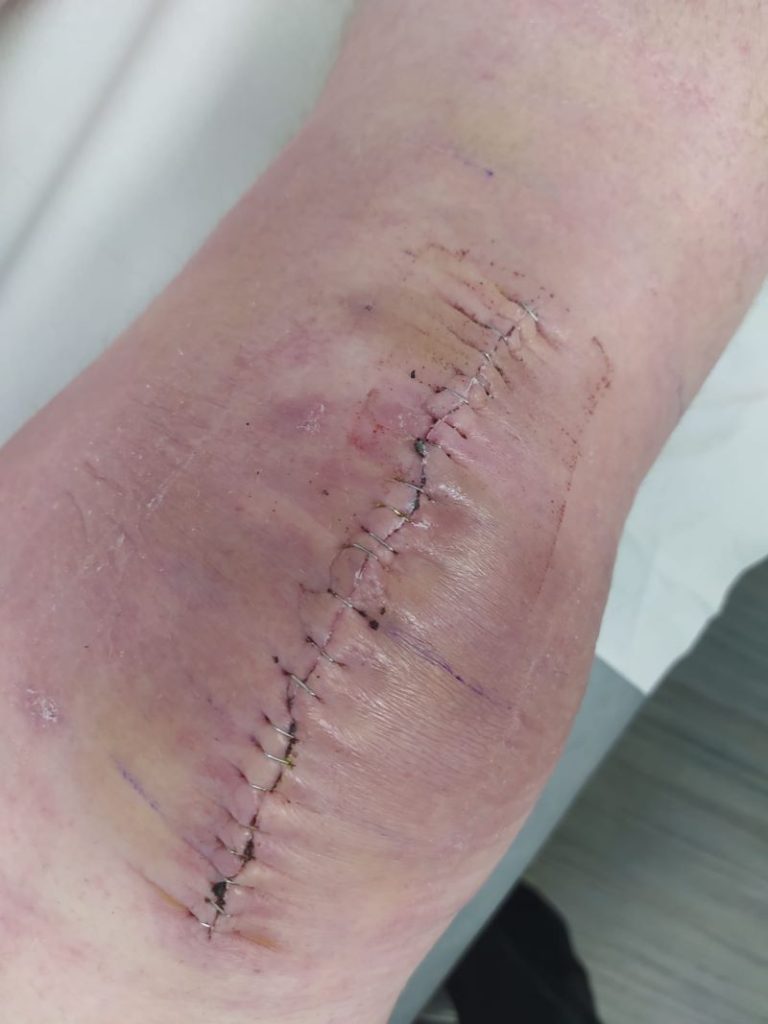
There followed 12 weeks of physio, both at the hospital, and importantly at home. I met several patients who swore not to go through this procedure again, which is understandable. It’s no stroll in the park. But I’d like to walk the earth again, because at the moment I can barely reach the end of a road.
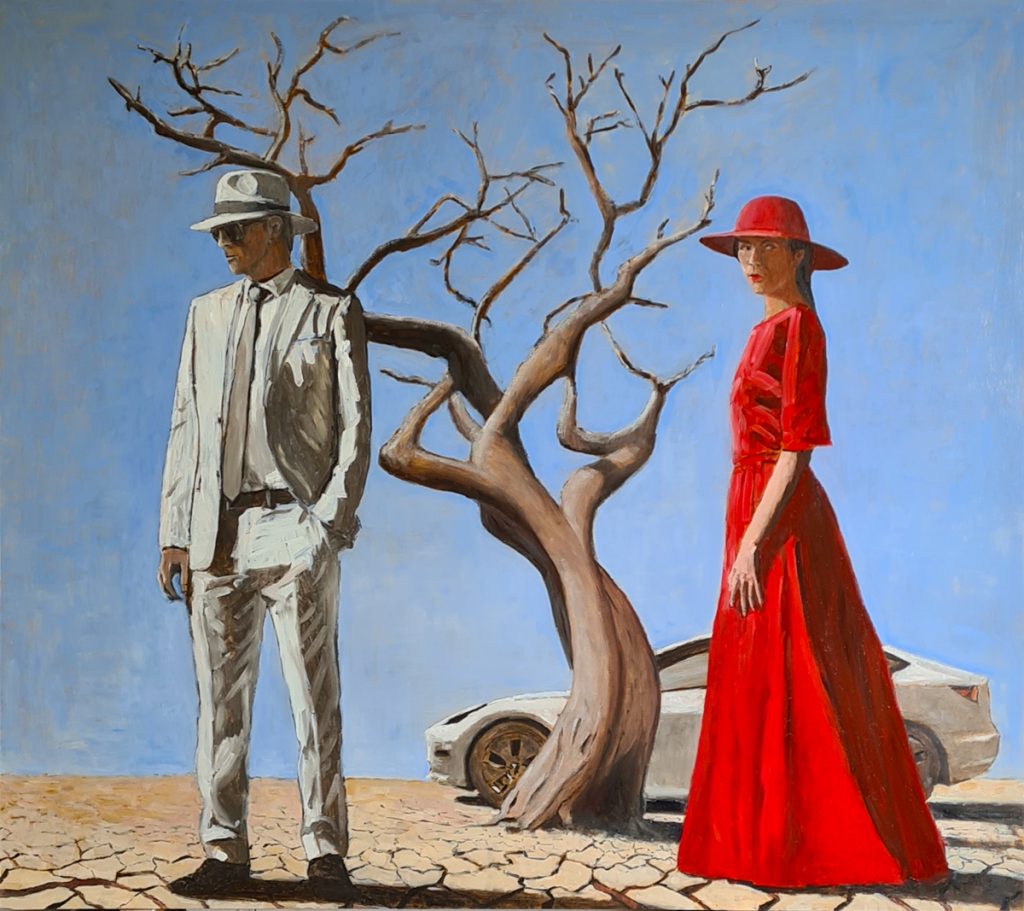
Yet, I’ve learned to cope. I have not stopped making art. I’ve adapted. I use new technology, AI, to replace a camera, which I am unable to use because of limited mobility. You can read about this here.
More importantly, I choose not to get unduly stressed. I take my time. I relax and sleep when I need to. Because if I don’t, it will only make matters worse.
I finally listened to my kids who had spent years saying, “Take a chill-pill, Dad.”
Although ankylosing spondylitis is incurable, there are new biologically engineered drugs that can work wonders, particularly for younger people. My advice to them would be to try these drugs.
A few years ago, I was prescribed a TNF inhibitor. Unfortunately I didn’t get on with the side effects. I’ve also tried sulfursalazine, methotrexate, and host of other drugs. I couldn’t bear the side effects from using any of them. Instead, I chose to keep things simple. I still take Naproxen. It’s the only drug I can tolerate. Long term use is risky, and so I take Famotodine to decrease stomach acid production. My blood is monitored regularly.
Although I don’t have coeliac disease, I eat a gluten-free diet. That simple change sorted out bowel problems in 48 hours.
I see a great rheumatologist, Professor Margaret Callan, at Chelsea and Westminster. She’s been in charge of my treatment for at least 20 years. My only fear is she will retire before I do. She’s promised to hang on. So I cling to hope, and next week, with fingers crossed, I will have a full complement of working knees. Luke Jones is guaranteeing them for 20 years. I plan to hold him to it.
God bless the NHS.
Update
It is now late April 2024, and I have had my other knee replaced by Luke Jones. Again I had a spinal tap, but no ketamine this time. I think that was a wise choice by the anesthetist, although I experienced dreams of the damned for a week.
The surgery has been very successful, and it was a considerably easier to deal with than the first. So maybe there’s something to be said for repeating the medicine.
I was discharged in 24 hours and I cast off the crutches within 2 weeks. I’m getting around just fine with a walking stick. I also began work on some digital new prints 10 days after leaving hospital. I will be posting something about these soon, but suffice to say they have been influenced by my dark dreams.
So once again for anyone who is doubtful about FKR surgery, it will hurt for a short while, but the payoff is worth it.